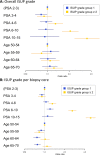Are Prostate Specific-Antigen (PSA) and age associated with the risk of ISUP Grade 1 prostate cancer? Results from 72 996 individual biopsy cores in 6 083 men from the Stockholm3 study
- PMID: 31194822
- PMCID: PMC6564040
- DOI: 10.1371/journal.pone.0218280
Are Prostate Specific-Antigen (PSA) and age associated with the risk of ISUP Grade 1 prostate cancer? Results from 72 996 individual biopsy cores in 6 083 men from the Stockholm3 study
Abstract
Background: Knowledge about the relationship between PSA, age and ISUP grade group (ISUP) 1 prostate cancer can improve clinical and biological understanding of prostate cancer. We aimed to investigate the associations between PSA and age and the risk of ISUP 1 and ISUP ≥ 2 prostate cancer, respectively.
Methods: We included 6 083 men aged 50-69 biopsied with a total of 72 996 individual biopsy cores from the prospective and population based Stockholm3 diagnostic study. We computed the risk of ISUP 1 and ISUP ≥ 2 prostate cancer and their respective associations with PSA and age. Since lower Gleason grades often are masked by higher grades in the overall Gleason score, we compared associations both for overall Gleason score and for Gleason on individual biopsy cores.
Results: ISUP 1 prostate cancer was not significantly associated with PSA at diagnosis: odds ratios ranged from 0.82 (95%CI: 0.68-1.00) for PSA 3-4 ng/mL, 0.96 (95%CI: 0.79-1.16) for PSA 4-6 ng/mL, 0.95 (95%CI: 0.75-1.21) for PSA 6-10 ng/mL, and 0.92 (95%CI: 0.58-1.45) for PSA 10-15 ng/mL compared with PSA 2-3 ng/mL. Age was not significantly associated with risk of ISUP 1 cancer. This contrasts to the strong relationship between ISUP ≥ 2 prostate cancer and its respective associations with PSA and age.
Conclusions: We find no significant association between the risk of ISUP 1 prostate cancer and PSA and age at diagnosis indicating that PSA contribution from ISUP 1 prostate cancer is closer to that of benign prostate tissue than to that of ISUP ≥ 2 prostate cancer.
Conflict of interest statement
We declare the following competing interests: Henrik Grönberg has five prostate cancer diagnostic related patents pending, has patent applications licensed to Thermo Fisher Scientific, and might receive royalties from sales related to these patents. Martin Eklund is named on four of these five patent applications. Karolinska Institutet collaborates with Thermo Fisher Scientific in developing the technology for the Stockholm3 prostate cancer diagnostic prediction model(1. PROGNOSTIC METHOD FOR INDIVIDUALS WITH PROSTATE CANCER. Publication info:WO2014079874 (A1)2014-05-30; 2. METHOD FOR INDICATING A PRESENCE OR NON-PRESENCE OF AGGRESSIVE PROSTATE CANCER, Publication info:WO2014079865 (A1)2014-05-30; 3. METHOD FOR INDICATING A PRESENCE OR NON-PRESENCE OF PROSTATE CANCER IN INDIVIDUALS WITH PARTICULAR CHARACTERISTICS, Publication info:WO2018141828 (A1)2018-08-09; 4. METHOD FOR DETECTING A SOLID TUMOR CANCER, Publication info: WO2015137870 (A1)2015-09-17; 5. METHOD FOR INDICATING THE PRESENCE OR NON-PRESENCE OF PROSTATE CANCER, Publication info: WO2013172779 (A2)2013-11-21). Other authors declare: no support from any organization for the submitted work; no financial relationships with any organizations that might have an interest in the submitted work in the previous three years; no other relationships or activities that could appear to have influenced the submitted work. This does not alter our adherence to PLOS ONE policies on sharing data and materials.
Figures


Similar articles
-
Lower urinary tract symptoms (LUTS) are not associated with an increased risk of prostate cancer in men 50-69 years with PSA ≥3 ng/ml.Scand J Urol. 2020 Feb;54(1):1-6. doi: 10.1080/21681805.2019.1703806. Epub 2019 Dec 26. Scand J Urol. 2020. PMID: 31876229
-
Prostate cancer screening using a combination of risk-prediction, MRI, and targeted prostate biopsies (STHLM3-MRI): a prospective, population-based, randomised, open-label, non-inferiority trial.Lancet Oncol. 2021 Sep;22(9):1240-1249. doi: 10.1016/S1470-2045(21)00348-X. Epub 2021 Aug 13. Lancet Oncol. 2021. PMID: 34391509 Clinical Trial.
-
Prostate-specific antigen velocity and prostate cancer gleason grade and stage.Cancer. 2007 Apr 15;109(8):1689-95. doi: 10.1002/cncr.22558. Cancer. 2007. PMID: 17330856
-
The Stockholm3 blood-test predicts clinically-significant cancer on biopsy: independent validation in a multi-center community cohort.Prostate Cancer Prostatic Dis. 2019 Mar;22(1):137-142. doi: 10.1038/s41391-018-0082-5. Epub 2018 Aug 31. Prostate Cancer Prostatic Dis. 2019. PMID: 30171228
-
Gleason scores provide more accurate prognostic information than grade groups.Pathology. 2025 Apr;57(3):293-296. doi: 10.1016/j.pathol.2024.12.633. Epub 2025 Jan 17. Pathology. 2025. PMID: 39924438 Review.
Cited by
-
Influence of Tumor Burden on Serum Prostate-Specific Antigen in Prostate Cancer Patients Undergoing Radical Prostatectomy.Front Oncol. 2021 Jul 29;11:656444. doi: 10.3389/fonc.2021.656444. eCollection 2021. Front Oncol. 2021. PMID: 34395240 Free PMC article.
-
A Simple Nomogram to Predict Clinically Significant Prostate Cancer at MRI-Guided Biopsy in Patients with Mild PSA Elevation and Normal DRE.Cancers (Basel). 2025 Feb 23;17(5):753. doi: 10.3390/cancers17050753. Cancers (Basel). 2025. PMID: 40075601 Free PMC article.
-
Prevalence of SPOP and IDH Gene Mutations in Prostate Cancer in a Jordanian Population.Biochem Genet. 2024 Dec 4. doi: 10.1007/s10528-024-10974-4. Online ahead of print. Biochem Genet. 2024. PMID: 39630373
-
A noninvasive method for predicting clinically significant prostate cancer using magnetic resonance imaging combined with PRKY promoter methylation level: a machine learning study.BMC Med Imaging. 2024 Mar 11;24(1):60. doi: 10.1186/s12880-024-01236-1. BMC Med Imaging. 2024. PMID: 38468226 Free PMC article.
-
Predictors of Clinically Significant Prostate Cancer in Patients with PIRADS Categories 3-5 Undergoing Magnetic Resonance Imaging-Ultrasound Fusion Biopsy of the Prostate.J Clin Med. 2022 Dec 25;12(1):156. doi: 10.3390/jcm12010156. J Clin Med. 2022. PMID: 36614957 Free PMC article.
References
Publication types
MeSH terms
Substances
LinkOut - more resources
Full Text Sources
Medical
Research Materials
Miscellaneous

